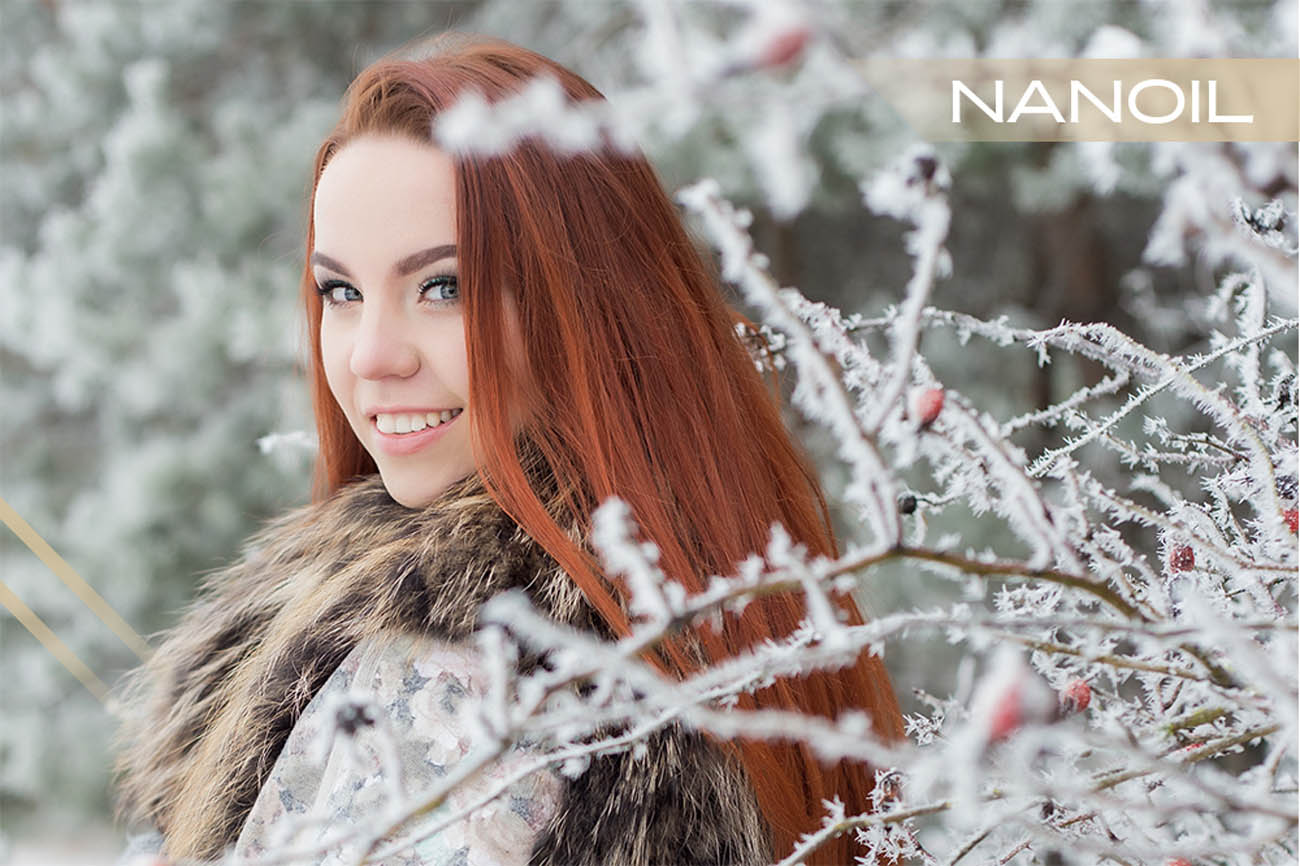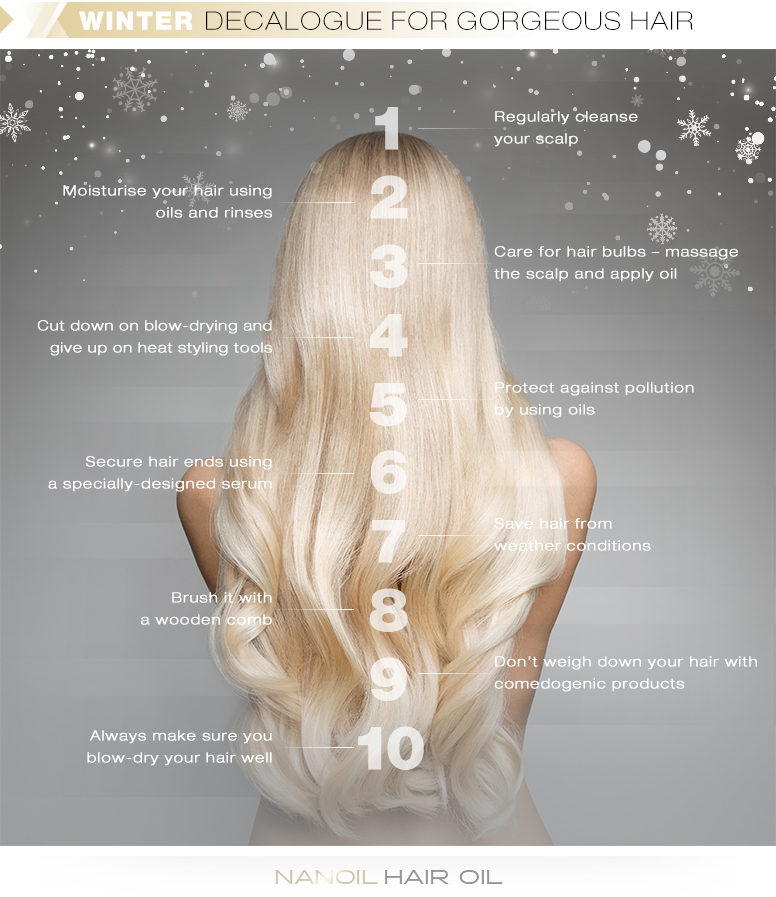- NANOIL Products
- Oils
- Face serums
- Hair masks
- Shampoos
- Hair conditioners
- Hair styling
- Hair Porosity Test
- Blog
- Contact

Shiny, strong, healthy hair is always a thing, no matter the season of the year. In winter, when the temperature outside remains below zero degrees, the looks of our hairdos leave a lot to be desired. Piercing wind, dry air inside, hiding hair under a hat – it doesn’t seem to be hair-friendly. We are all familiar with static flyaways, scalp oiliness, lack of volume, dehydration, damaged hair (ends), unruly strands. What should your winter hair care look like?
Winter isn’t (at all!) a hair-friendly season of the year. Wrong hair care strikingly weakens both inner and outer hair structures, including hair bulbs. It’s because hair’s exposed to sudden and quite drastic changes in temperatures: frosty air outside and dry heated air inside – it isn’t a good duet for your hairdo.
Wearing a hat and scarf or hiding strands under a turtleneck don’t give you desired effects in hair care. Hair is weighed down and loses volume, your scalp is deprived of the proper blood flow, hair’s greasy and the scarf makes hair ends break. Consequently, your hairdo is no longer vital or gorgeous-looking. How to restore hair shine, bounce and strength to keep damage away in harsh winter?
Cool days mean much oilier hair, which results from wearing a warm hat. Hair doesn’t keep fresh whereas the scalp is bothered by sebum excess because sebaceous glands work more intensively. In order to keep hair voluminous, feel free to wash it every day: go for a mild balancing natural shampoo.
You’re saved from the hat hair if you spray some dry shampoo to the roots e.g. before a big date. The product lifts the roots, boosts volume and holds back excessive sebum secretion. The important thing is you don’t make it a habit. When you apply a dry shampoo, it is advisable to wash hair on the next day.
In order to save hair from the dry air, provide it with sufficient moisture. The rule applies to both hair lengths and scalp which tends to lose hydration due to overheated air emitted by heaters and blow-dryers. During winter season, hair loses water quickly and its cuticles are raised. As a consequence, it’s more prone to damage.
Delivering moisture is the base for hair care – apart from a balancing product, reach for a moisturising shampoo (lots of shampoos for greasy hair also contain ingredients keeping hair and scalp moisturised).
Micellar hair products are innovative and cut out for the winter. Lots of them gently purify the scalp, not making it dry. Moisturising hair masks/conditioners and herbal scalp treatments make an excellent choice, soothing irritated scalp and locking moisture in.
If your hair’s crying for moisture – go to the hairdresser’s and treat it to hair steam treatment which is a rapid way of nourishing. You should do your best to keep the effect as long as possible – at-home hair oil treatment will work as the strongest enhancement. Do it at least once a week.
Apart from a regular use of a balancing shampoo, hair oil treatment will ensure undisturbed scalp balance. Unique qualities of natural oils (especially jojoba oil) keep scalp clean and free from sebum excess.
When it comes to extremely greasy hair, it needs intensively-working products. A balancing shampoo isn’t enough to get rid of sebum overload. If you struggle with this problem, do scalp exfoliation once a week (get a ready-made scrub or make your own using natural oils). Not only does the scrub remove sebum excess but also frees you from product buildup, various toxins and impurities. Exfoliation increases blood flow, delivers oxygen to skin cells and stimulates bulbs for faster hair growth. What’s more, a scrub is a perfect remedy for flat, weighed down hair – a gentle scalp massage lifts the roots for a nice volume boost.
Hair tips get damaged the fastest – that’s the hair part which is longest with us. Consequently, they have time to get injured because of unfavorable weather conditions, wrong hair care and irregular trimming. That’s the hair fragment which gets dry, loses color and splits the fastest. Hair ends are often extremely frizzy and this is the very hair part where damage of inner structures begins.
The best you can do is cut hair ends regularly and use a special serum to protect them from dry air and harsh temperatures. Apart from silicone-based products, natural oils fulfill this role – not only do they protect hair on the outside (leaving a microscopic shield protecting from damage) but also reinforce inner hair structures and keep hair ends from splitting.
The bulb of hair is its most crucial part – if its condition gets weaker, the hair falls out of the follicle easily. To make things worse, the hair growth is hindered. Strands might grow out weaker and more prone to damage. When a hat, frost and heated air give your hairdo a hard time, hair care should be mostly based on applying hair oil treatments. Natural oils are rubbed both in hair lengths and scalp to stimulate its work, nourish the hair matrix and deliver numerous valuable vitamins, phytosterols, flavonoids and good omega fatty acids. Hair oil treatment is the best and most effective home therapy you can present your hairdo with.
Unruly strands – the winter menace many women try to combat. It usually affects fragile, thin hair yet it happens that thick heavy hair loses the battle with dry air, hats or laundry detergents which largely intensify hair static.
If your strands notoriously go in different directions and a hair brush routine only makes them look worse, try a shampoo enriched with natural oils (get a ready-made product or add a drop or two of a natural oil to a regular shampoo).
A specially-designed anti-static hair spray is another good choice. It gives the best effect when you spray it inside your hat and onto the scarf and gently dampen the brush before combing hair. Speaking of hair brushes, they might be causing static flyaways, too. If so, replace it with a wide-tooth wooden comb – you will keep static away as well as take care of your hair and massage the scalp.
Volume (to be more precise, lack of it) is the biggest problem you’re likely to face up to in winter. In order to keep your hair voluminous, use a few tried and tested tricks. Undoubtedly, a scalp massage is the priority - e.g. the massage you do while applying hair oil treatments. Not only does it nourish the bulbs but also lifts hair roots and adds body and volume to hair.
Blow-drying your hair upside down is another good way. When strands are still slightly damp, use a mild styling lotion – natural and free from synthetics.
Your hair will also look good when you use a homemade flaxseed gel. To avoid weighed-down hair in winter, use a lightweight conditioner and shampoo. In this way, you’re certain that your hair gets due care and products don’t disturb the balance of scalp.
If hair stays in touch with harsh weather, it gets weaker and more damaged more quickly – it makes sense. Too bad, in winter, even when you go back home to a warm place – your hair has no chance for a rest because dry and overheated air gives it a hard time, too.
Protecting hair from damage is one of the most important elements in winter hair care. Natural oils and at-home hair oil treatment turn out to give the best results, working in multiple ways: not only do they protect hair from the outside but also fix inner structure and reinforce bulbs.
It’s best when you choose the right oil for your hair porosity and condition – you should try an online hair porosity test and pick the proper blend of oils. One of the three Nanoil hair oils will be cut out for winter hair care, designed for various porosities, types and condition of hair.

Alcohols in products facilitate absorption. Long-chain alcohols won’t do harm even in the long run. Too bad, most products contain at least one strongly-dehydrating short-chain alcohol which leads to hair dehydration and has a comedogenic effect on your scalp when used regularly. The hair-unfriendly group involves alcohol denat, benzyl alcohol, etanol alcohol, isopropyl alcohol (IPA).
Heavy silicones in products work as the ‘bad’ alcohols, leaving scalp dehydrated and irritated. While shopping for winter hair care products, avoid silicones such as simethicone, trimethicone or trimethylsiloxysilicates.
Hot flat iron plates, blow-dryer’s airflow plus changeable dry and frosty air… might be too much your hair is able to handle. If you really want to do your best to keep hair vital and avoid damage – use a straightener occasionally or give it up. You will save your hairdo from irreversible changes in its structure. While blow-drying, use a cool airflow – hair won’t lose moisture and water. Moreover, cuticles will be sealed for fabulous luminous hair.
Of course, this activity is forbidden regardless of the season of the year. However, remember that invasive towel-drying plus a few months of unfavorable conditions (both inside and outside) bring hair damage twice as quickly. Harsh towel-drying or going to sleep with wet hair may end up in hair breakage and damaged external keratin later (which aims at protecting hair from damage and dryness).
Natural plant-based hairstyling products are definitely worth choosing. After all, they let you style a hairdo, nourishing and protecting at the same time. On the other hand, if you overuse synthetic mousses and hair sprays, you coat and weigh down your hair with chemicals which may cause dehydration. A hair mousse, spray, gel or paste deteriorate the state of your scalp, disturbing the natural circulation.
Going to sleep with wet or damp hair (or even worse – going out with damp hair) is an easy way to catch a cold. Hair suffers a lot, too. Wet hair is more delicate and prone to damage; its structure becomes wrecked quickly. Hair fibers are extremely hard to rebuild.
They may intensify hair static, tuck and pull out the strands. If you are serious about hair care, reach for the right brush or comb. A wide-tooth wooden comb is one of the best you can pick – it combs your hair, massages the scalp and improves blood flow thus delivers oxygen to hair bulbs.
Even though too many detergents and fabric softeners give hats and scarves a beautiful aroma and softness, they are not going to upgrade your hair. Most washing powders, softeners and pods have the same electric charge as hair. So… if you put too much effort into washing your scarves, hats or sweaters, your hair is surely going to turn into static flyaways. To reduce that, choose anti-static softeners and cut down on detergents while doing laundry.
Leave your email address and we ll notify you when it s back in stock.
Comments: #0